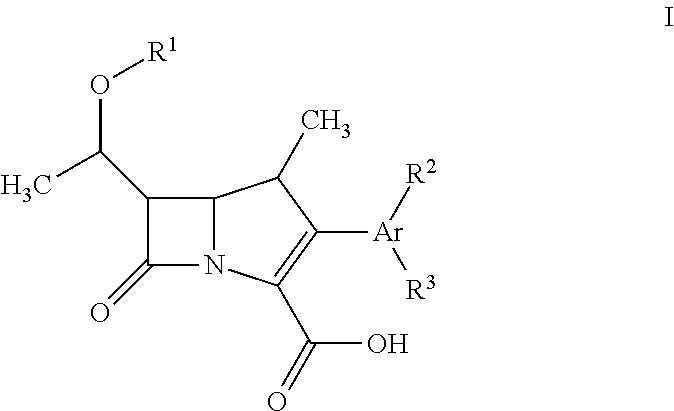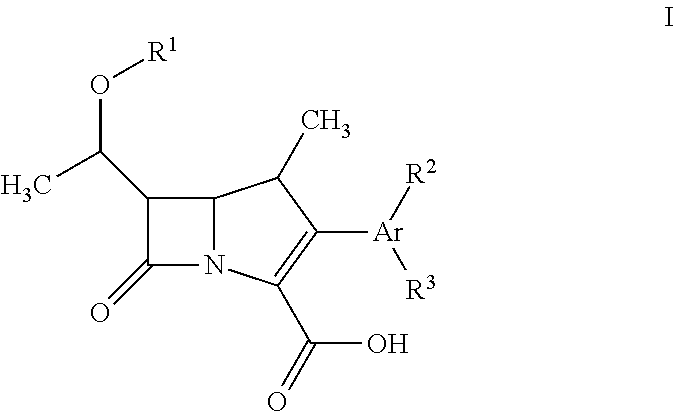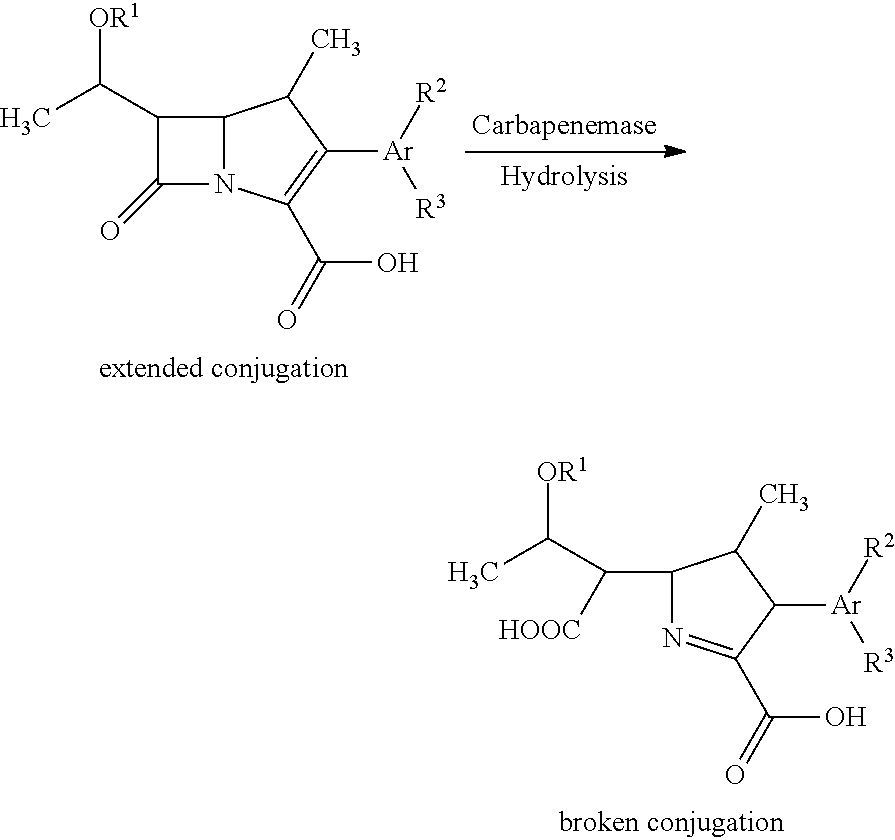Fluorescent carbapenems
a carbapenem and fluorescence technology, applied in the field of fluorescent or chromogenic carbapenems, can solve the problems of difficult mic determination, inability to distinguish between penicillinases, cephalosporinases or esbls versus carbapenems, and inability to do so
- Summary
- Abstract
- Description
- Claims
- Application Information
AI Technical Summary
Benefits of technology
Problems solved by technology
Method used
Image
Examples
example 2
Preparation of potassium-(4S,5R,6S)-6-[(1′R)-hydroxy-ethyl]-4-methyl-7-oxo-3-(4-amino-phenyl)-1-aza-bicyclo[3.2.0]hept-2-ene-2-carboxylate
[0073]
(4S,5R,6S)-4-methyl-3-(4-nitro-phenyl)-7-oxo-6-((1′R)-triethylsilanyloxy-ethyl)-1-aza-bicyclo[3.2.0]hept-2-ene-2-carboxylic acid 4-nitro-benzyl-ester
[0074]In a 25 ml Schlenk flask fitted with a rubber septum, magnetic stirrer and a balloon filled with dry nitrogen at −78° C. to a solution of (4R,5S,6S)-4-methyl-3,7-dioxo-6-((1′R)-triethylsilanyloxy-ethyl)-1-aza-bicyclo[3.2.0]heptane-2-carboxylic acid 4-nitro-benzyl-ester (440 mg, 0.92 mmol) in dry dichloromethane (3.6 ml) was added triethylamine (128 μl, 0.92 mmol). After 15 min, trifluoromethanesulfonic anhydride (156 μl, 0.92 mmol) was added to the resulting orange-yellow solution. After 30 min at −78° C., Pd(dba)2 (28 mg, 0.048 mmol, 5 mol %), a solution of 4-nitro-phenyl-boronic acid (132 mg, 0.80 mmol) in tetrahydrofuran (6.0 ml), and aqueous potassium hydroxide (520 μl, 2.28 mmol, 5.4 ...
example 3
Preparation of potassium-(4S,5R,6S)-3-(4′-acetyl-biphenyl-4-yl)-6-[(1′R)-hydroxyethyl]-4-methyl-7-oxo-1-aza-bicyclo[3.2.0]hept-2-ene-2-carboxylate
[0078]
(4S,5R,6S)-3-(4′-Acetyl-biphenyl-4-yl)-4-methyl-7-oxo-64(1′R)-triethylsilanyloxy-ethyl)-1-aza-bicyclo[3.2.0]hept-2-ene-2-carboxylic acid 4-nitro-benzyl-ester
[0079]In a 25 ml Schlenk flask fitted with a rubber septum, magnetic stirrer and a balloon filled with dry nitrogen at −78° C. to a solution of (4R,5S,6S)-4-methyl-3,7-dioxo-6-((1′R)-triethylsilanyloxy-ethyl)-1-aza-bicyclo[3.2.0]heptane-2-carboxylic acid 4-nitro-benzyl-ester (110 mg, 0.23 mmol) in dry dichloromethane (0.9 ml) was added triethylamine (32 μl, 0.23 mmol). After 15 min, trifluoromethanesulfonic anhydride (39 μl, 0.23 mmol) was added to the resulting orange-yellow solution. After 30 min at −78° C., Pd(dba)2 (7 mg, 0.012 mmol, 5 mol %), a solution of 4′-acetyl-biphenyl boronic acid (48 mg, 0.20 mmol) in tetrahydrofuran (2.5 ml), and aqueous potassium hydroxide (130 μl,...
example 4
Preparation of potassium-(4S,5R,6S)-3-(4-acetyl-phenyl)-6-[(1′R)-acetoxyethyl]-4-methyl-7-oxo-1-aza-bicyclo[3.2.0]hept-2-ene-2-carboxylate
[0082]
(4S,5R,6S)-3-(4′-Acetyl-biphenyl-4-yl)-6-(1′R)-acetoxy-ethyl)-4-methyl-7-oxo-1-aza-bicyclo[3.2.0]hept-2-ene-2-carboxylic acid 4-nitro-benzyl-ester
[0083]In a 10 ml Schlenk flask fitted with a rubber septum, magnetic stirrer and a balloon filled with dry nitrogen at 0° C. to a solution of (4S,5R,6S)-4-methyl-3,7-dioxo-6-(1′R)-hydroxy-ethyl)-1-aza-bicyclo[3.2.0]heptane-2-carboxylic acid 4-nitro-benzyl-ester (10 mg, 0.022 mmol) in dry dichloromethane (2.0 ml) was added a solution of dimethyl-pyridin-4-yl-amine (2.7 mg, 0.022 mmol) in dry dichloromethane (0.5 ml). Acetic acid chloride (1.6 μl, 0.022 mmol) was added. After 1 h at 0° C., the opaque solution was diluted in toluene (20 ml), washed once with saturated aqueous NaHCO3 (10 ml), once with water (10 ml), once with brine (10 ml) and dried over magnesium sulfate. After filtration, the solven...
PUM
| Property | Measurement | Unit |
|---|---|---|
| wavelength | aaaaa | aaaaa |
| temperature | aaaaa | aaaaa |
| temperature | aaaaa | aaaaa |
Abstract
Description
Claims
Application Information
 Login to View More
Login to View More - R&D
- Intellectual Property
- Life Sciences
- Materials
- Tech Scout
- Unparalleled Data Quality
- Higher Quality Content
- 60% Fewer Hallucinations
Browse by: Latest US Patents, China's latest patents, Technical Efficacy Thesaurus, Application Domain, Technology Topic, Popular Technical Reports.
© 2025 PatSnap. All rights reserved.Legal|Privacy policy|Modern Slavery Act Transparency Statement|Sitemap|About US| Contact US: help@patsnap.com



